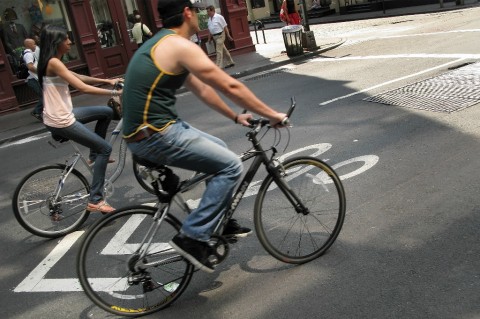Transportation Secretary Ray LaHood has announced a “major policy revision” that aims to give bicycling and walking the same policy and economic consideration as driving.
“Today I want to announce a sea change,” he wrote on his blog last week. “This is the end of favoring motorized transportation at the expense of nonmotorized.”
The new policy, which was introduced a few days after Mr. LaHood gave a well-received speech from atop a table at the National Bike Summit, is said to reflect the Transportation Department’s support for the development of fully integrated transportation networks.
It calls on state and local governments to go beyond minimum planning and maintenance requirements to provide convenient and safe amenities for bikers and walkers. “Walking and biking should not be an afterthought in roadway design,” the policy states.
Transportation agencies are urged to take action on a number of fronts, including the creation of pathways for bike riders and pedestrians on bridges, and providing children with safe biking and walking routes to schools.
They are also encouraged to find ways to make such improvements in concert with road maintenance projects and to protect sidewalks and bike lanes in the same manner as roads (by clearing them of snow, for example).
Mr. LaHood also indicated the department is discouraging “transportation investments that negatively affect cyclists and pedestrians.”
Not surprisingly, the news had bike enthusiasts excited.
“It is simply the strongest statement of support for prioritizing bicycling and walking ever to come from a sitting secretary of transportation,” said Darren Flusche, policy analyst for the League of American Bicyclists.
Nonetheless, some business groups have expressed concern that giving walking and biking the same policy considerations as other transportation modes, as Mr. LaHood recommended, would impede progress on other fronts.
“Treating bicycles and other nonmotorized transportation as equal to motorized transportation would cause an economic catastrophe,” warned Carter Wood, a senior adviser at the National Association of Manufacturers. “If put it into effect, the policy would more than undermine any effort the Obama Administration has made toward jobs. You can’t have jobs without the efficient movement of freight.”
At a House appropriations committee hearing last week, Congressman Steven LaTourette, Republican of Ohio, brought up the new policy and asked a Transportation Department official to clarify what Mr. LaHood means by “equal treatment.”
“If we’re going to spend $1 million on a road, we’re not going to have half of it go to a bike lane and half of it go to cars?” he asked, according to a transcript of the hearing.
“My interpretation of that would be equal in the eyes of policymakers as what is the expenditure you make, what is the benefit you get,” responded Roy Kienitz, D.O.T.’s under secretary for policy. “And if the freight project offers the best bang, great, but if the bike project offers a good bang, great for them.”
“I don’t even understand how you get a bang for the buck out of a bicycle project,” Mr. LaTourette subsequently commented. “I mean, what job is going to be created by having a bike lane?”
From New York Times
Another take on it here...
Transportation's bicycle policy hits potholes (USA)

